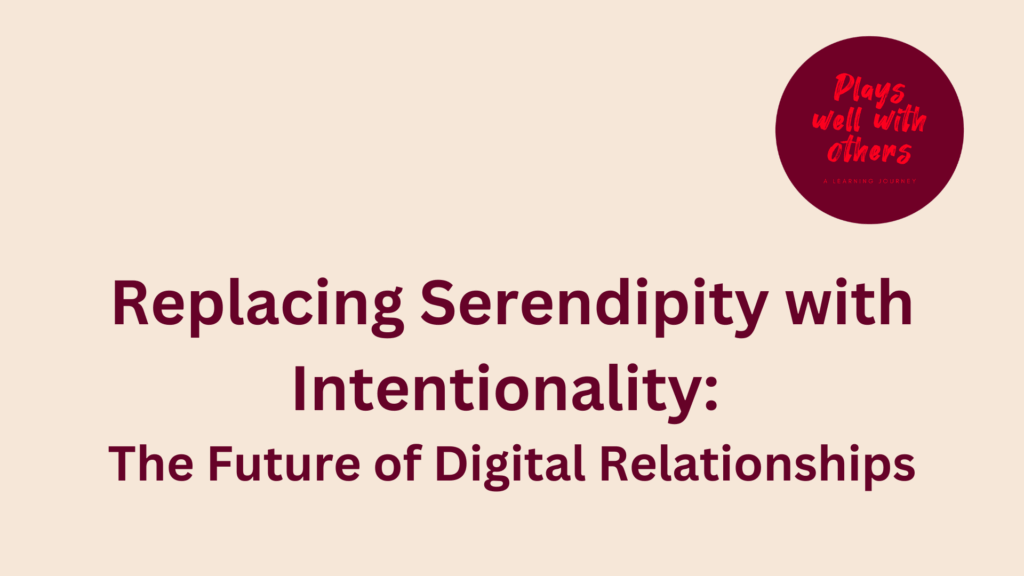There’s a moment that happens in every traditional office—you’re rushing to a meeting, someone catches your eye in the corridor, and suddenly you’re having the conversation that changes everything. Perhaps it’s learning about a colleague’s hidden expertise, discovering a shared challenge, or simply seeing them laugh at something absurd. These fleeting encounters, so unremarkable we rarely remember them, form the invisible architecture of workplace relationships.

Digital work has fundamentally altered this landscape. Traditional relationship building relies heavily on unplanned moments—the corridor conversation, the shared lift journey, the spontaneous coffee. These “weak tie” interactions, as sociologist Mark Granovetter termed them, actually strengthen workplace bonds more than we realise. Yet digital work strips them away entirely. Everything becomes scheduled and purposeful, losing the organic quality that builds genuine connection.
The result isn’t just loneliness—it’s a fundamental shift in how relationships form and deepen. When every interaction requires a calendar invitation, we unconsciously begin rationing our social investment. We stick to our immediate team, our essential contacts, our scheduled touchpoints. The peripheral relationships that drive innovation, opportunity, and organisational resilience quietly wither.
But here lies both the challenge and the opportunity: if spontaneous connection was the foundation of traditional workplace relationships, what becomes the foundation in a digital world?
The Art of the Asynchronous Relationship
Perhaps our biggest misconception is that connection requires real-time interaction. The digital environment offers something traditional offices never could: the ability to build relationships across time and space through thoughtful, considered exchange.
Consider the power of a voice message that captures not just information but tone, personality, and care. Or collaborative documents where personal commentary reveals thinking patterns and values. These asynchronous touchpoints allow for a different kind of intimacy—one where people can share more authentically because they have time to reflect, where introverts can participate more fully, where working parents can engage outside traditional hours.
The strongest digital relationships often develop through these layered, time-shifted interactions that build understanding incrementally rather than through the binary of meeting or not meeting.
Reframing Transactional Touch Points
Every work interaction contains relationship-building potential if we know how to recognise and activate it. The routine email, the project update, the quick Teams call—each represents a choice between purely transactional efficiency and human connection.
This isn’t about making everything longer or more complex. It’s about recognising that how we handle these everyday moments shapes the quality of our working relationships. The colleague who asks “How’s your week shaping up?” before diving into project details. The manager who notices energy levels during check-ins. The team member who shares a genuine reaction to someone’s idea rather than simply moving to the next agenda item.
These micro-investments in connection don’t require additional time—they require additional intention. And their cumulative impact on relationship quality is profound.
Intentional Informality
Perhaps the most significant shift required is accepting that casual doesn’t happen naturally online—it must be deliberately created. Since serendipity doesn’t emerge organically in digital spaces, we must engineer opportunities for the human moments that build trust and understanding.
This might mean starting meetings by actually asking how people are and leaving space for real answers. It could involve creating dedicated “non-work” digital spaces where teams can share what they’re reading, what they’re struggling with, or what made them laugh that week. Most importantly, it means embracing rather than apologising for the domestic interruptions that give us glimpses into each other’s full humanity.
The death of serendipity in digital work isn’t a problem to solve—it’s a reality to adapt to. The organisations that thrive won’t be those trying to recreate the past, but those bold enough to pioneer new forms of human connection that work within our digital present.
The question isn’t whether we can build meaningful relationships through screens. We already are. The question is whether we’re doing it intentionally enough to create the kind of workplace relationships that sustain us, inspire us, and help us do our best work together.
What moments of unexpected connection have shaped your own career? And what might intentional relationship building look like in your current digital environment?